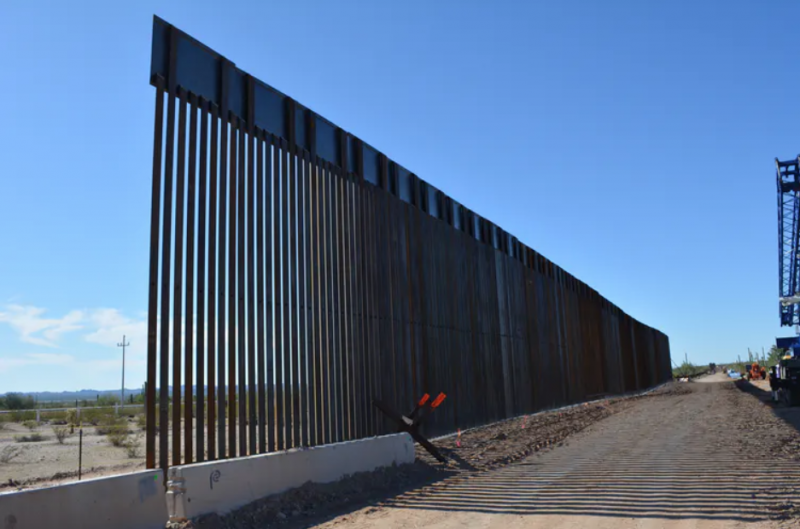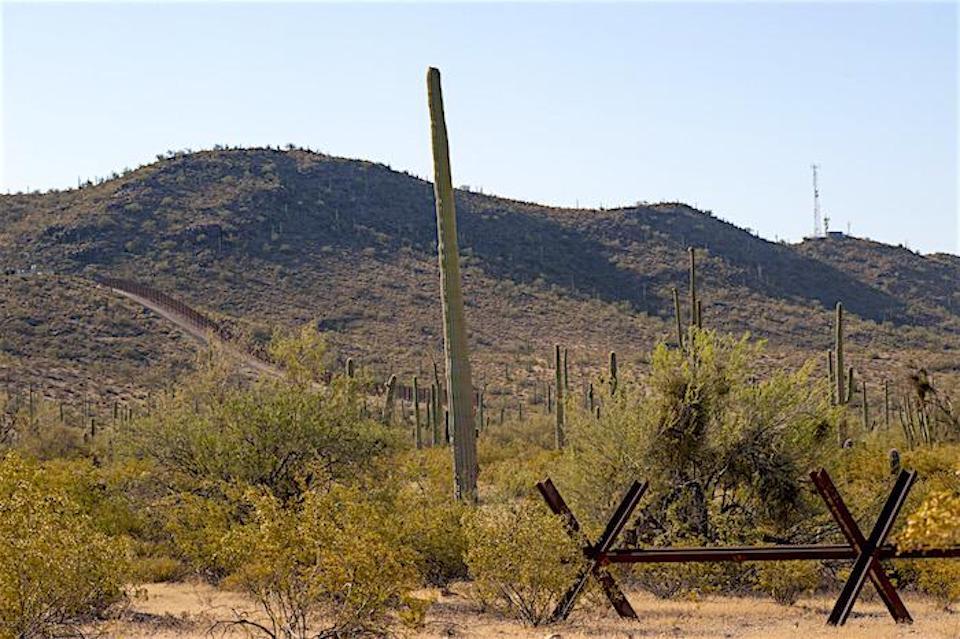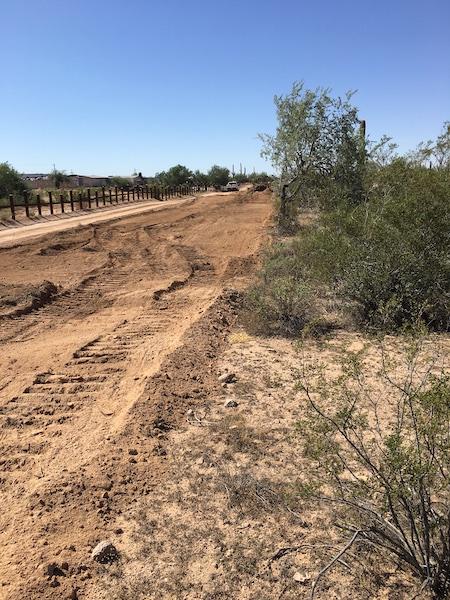
Workers erecting a border wall in Organ Pipe Cactus National Monument in Arizona have turned to explosives to help get the job done/File photo by Jared Corsi, Colorado State University
Though rich in biodiversity and a resplendent portrait of the Sonoran Desert, Organ Pipe Cactus National Monument has been transformed in places into a construction zone, complete with blasting to chew into a hillside so President Trump's border wall can be installed.
“The construction contractor has begun controlled blasting, in preparation for new border wall system construction within the Roosevelt Reservation at Monument Mountain," the U.S. Customs and Border Protection said Friday in a brief statement distributed to inquiring media. "The controlled blasting is targeted and will continue intermittently for the rest of the month."
While the agency said an "environmental monitor" was present during the blasting along the strip of land along the U.S.-Mexico border, they couldn't say exactly what that individual's role would be. CBP also didn't know whether there was an archaeologist on hand in the event human remains or artifacts associated with the hundreds of years of known human presence on the landscape, dating to Classic Hohokam Period that dates to between 300 and 1500 AD, were found.
However, CBP staff said they'd seek answers to those questions. They did note, though, that the area where the wall's construction is ongoing has been disturbed over the years and studied for any archaeological remains.
"This is a clear area," they said. "They shouldn't be finding any new archaeological remains."
The area has seen quite a bit of disturbance since Organ Pipe was designated a national monument in 1937 by President Franklin D. Roosevelt. A dirt road runs the length of the border inside the monument, and vehicle barriers reminiscent of the World War II Normandy style barriers long have stood as impediments along the border. Additionally, in 1959 the National Park Service Park rehabilitated the Quitobaquito area in the monument's southwestern corner, deepening the pond there and solidifying its banks, along with razing some buildings. Cattle ranching that continued inside the monument until 1978 also impacted the landscape.

Normandy style barriers have been used to impede vehicle crossings at Organ Pipe Cactus NM/Patrick Cone file
But the desire by President Trump to try to impede border crossings has intensified work not normally seen in a park where the Park Service is directed to preserve the natural resources, and which is an International Biosphere Reserve. Bulldozers have rumbled along the border, clearing way for the wall's construction, and now explosives are being used to chew into the landscape for better anchoring of the wall of concrete-filled steel bollards.
“I’ve visited Organ Pipe National Monument’s southern border several times since the wall construction began. I’ve seen a bulldozer scraping the landscape bare, including many of the park’s iconic saguaro cacti, to install a new 30-foot wall to replace an existing barrier," Kevin Dahl, the National Parks Conservation Association's senior Arizona program manager, said Friday. "This expensive and unneeded new wall is destroying the very things our national parks were created to preserve and protect. As this rapid-paced, destructive practice has progressed, such vital resources have faced bulldozers, chainsaws, and now dynamite. There are so many costs with this construction that are being ignored, for so little benefit.”
While CBP staff maintain the area where the wall is being constructed isn't expected to contain any human remains, last summer a National Park Service field survey along 11 miles of the national monument near where the wall is being built identified five archaeological sites, and left the archaeologists of the mind that "significant, presently-unrecorded surface-level and buried archaeological deposits persist across the project (are), and we must assume that all such unrecorded deposits will be destroyed over the course of ensuing border wall construction."

Construction work for the border wall involved the use of bulldozers to scrape clean the construction area/Kevin Dahl, NPCA file
Dr. Andrew Veech, who works for the Park Service's Intermountain Region Archaeology Program, noted in the report that the Park Service had been told that once the construction began, the work would occupy a 60-foot wide swath of what's known as the "Roosevelt Reservation" in the monument. All told, the work could affect 218 acres within Organ Pipe, the report said.
"...the NPS regards the entire 18.3 m- (60-foot-) wide Roosevelt Reservation as an area of great concern, whose cultural and natural resources are imperiled."
Veech's team found five archaeological sites during their brief survey, all of which contained various flaked lithic artifacts, such as obsidian, chalcedony, basalt, or chert, and volcanic igneous rock. Three of the sites contained either brownware or red ceramic sherds, or both, and two contained marine shell fragments.
The sites were fairly small in area, from nearly a half-acre to as little as 0.05-acre in size. Some could have been used for a "short-term encampment, perhaps one used and occupied at some point during the Archaic period (8,500 BCE-300 CE)," the report noted. The largest site contained flaked obsidian artifacts as well as five "marine shell fragments."
"Together with the 5 marine shell fragments, these obsidian artifacts denote the southwest-to-northeast transport of exotic raw materials from ... the Gulf of California and Pinacate Peaks of Sonora, Mexico, into southwestern Arizona," the report added.
A brass .45-.70 caliber rifle shell casing from the late 1800s also was discovered. "The .45-.70 rifle cartridge was adopted by the U.S. Army in 1873 as the service cartridge for its trap-door Springfield rifle," the archaeologists' report noted. "The Army continued using the .45-.70 cartridge until 1892, when it was replaced by the .30-.40 caliber Krag cartridge."
The Sonoran Desert cradled by Organ Pipe Cactus is unlike most other deserts in the world. It receives more rainfall, on average, than other deserts, and is biologically rich, with more than 600 plant species and more than 50 mammalian species. Nearly 300 bird species, and 50 types of amphibian and reptilian species, also have been counted in the monument. Taken as a whole, it’s understandable why the park in 1976 was designated an International Biosphere Reserve.
There’s rich human history here, too, dating back 15,000 years. The Old Salt Trail was used by cultures down through the centuries to bring salt, seashells, and obsidian gathered from Sea of Cortez salt beds at Sonora, Mexico, northward through this landscape. The Tohono O’odham culture relied on the fruit of the saguaros and organ pipe cactus for food.



Comments
Why can't the story like this be written without politcal bias. As soon as I read the authors term "Trumps wall" I knew that I would need to read closer to scrape out facts rather than conjecture.
So, are you somehow operating under the assumption that any other administration, regardless of political affiliation, would be redirecting this much of America's resources to build this kind of wall using these kinds of construction methods in these kinds of protected areas? I'm old enough to have clear memories of the Eisenhower, Nixon, Reagan, and George H. W. and George W. administrations and I didn't see much to agree with in any of them. But, I can strongly attest that none of them, not one, would have spent this much to build this kind of wall this way thorough these protected areas. No, this wall is not a republican thing. It's certainly not a democrat thing. No, this is "Trump's border wall" and any bias you perceive is not a political bias; it's a bias against corruption, narcissistic personality disorder, and the cowardice of sycophants.
Agree with Egre.
Rump - the Dems were calling for a wall before it was Trump's effort to actually make it happen. This isn't Trump's wall its America's wall.
Candidate Donald Trump called for a border wall during his campaign, and less than a week after he was inaugurated he signed an executive order, Border Security and Immigration Enforcement Improvements, specifically calling for the wall to be build.
When Congress wouldn't finance the wall, the president allowed for a partial government shutdown. He soon thereafter diverted money to have construction begin -- declaring a national emergency to justify the diversion -- and he has repeatedly stated he would build the wall and make Mexico pay for it.
All that said, is it a pejorative to refer to it as Trump's wall? After all, Congress wouldn't go along with it. It's his tenacity that has gotten it this far. Perhaps to Democrats it's a pejorative, but is it also to Republicans who supported his push for the wall?
The facts in the story were clearly presented, even those noting that the area where the wall is being installed was not a pristine section of land in the national monument. If there's some obfuscation that was unintentionally inserted, please point it out and we'll rewrite the section if needed.
Kurt..
If any of the trumpian apologists come with anything for your challenge, please let us all know?
Not a pejoritive Kurt. I am proud to give Trump credit for making it happen. But he wasn't the first with the idea. In 2006, Congress passed the Secure Fence Act overwhelmingly with substantial Democratic support from the likes of Obama, Biden, Clinton, Schumer et al. This is not a Dem vs Rep issue it is an American issue. At least is was until Trump made it happen.
You put up anything that doesn't allow for water flow from north to south and that solid wall will only be a dam.